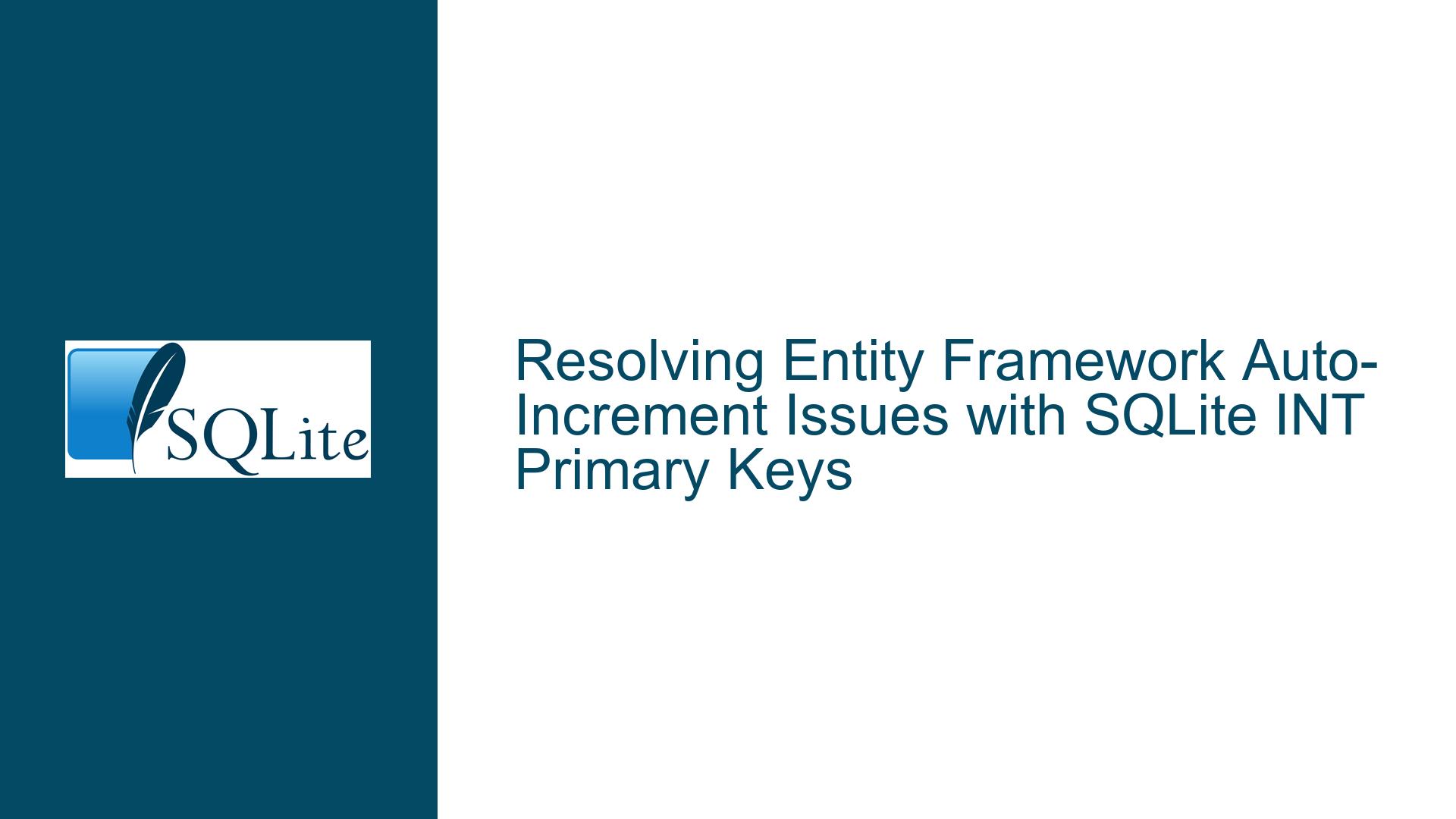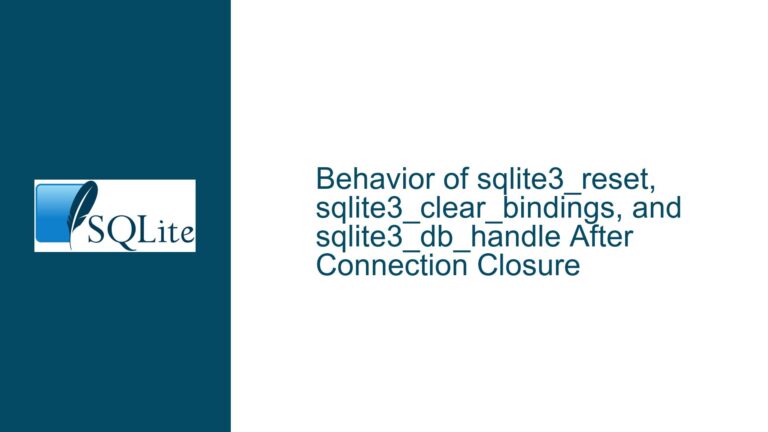Resolving Entity Framework Auto-Increment Issues with SQLite INT Primary Keys
Understanding the Conflict Between Entity Framework and SQLite’s Auto-Increment Requirements
Issue Overview
The core challenge arises from a mismatch between SQLite’s strict requirements for auto-incrementing primary keys and Entity Framework’s default type mappings. In SQLite, only columns explicitly declared as INTEGER (case-insensitive) can behave as ROWID aliases, which is a prerequisite for native auto-increment functionality. When a primary key is defined as int in the database schema (common in legacy systems or third-party-controlled designs), SQLite treats it as a typeless column, bypassing the automatic row ID assignment mechanism.
Entity Framework (EF) exacerbates this problem through its default conventions. EF maps C# int properties to SQLite’s INTEGER type only if the model is configured correctly. However, if the underlying database schema enforces int as the column type (not INTEGER), EF cannot leverage SQLite’s auto-increment behavior. This results in insertion errors during POST operations, as the primary key remains unpopulated.
The conflict is further complicated by SQLite’s type affinity system. Columns defined as int have NUMERIC affinity, whereas INTEGER-typed columns have INTEGER affinity. The latter is directly tied to SQLite’s internal ROWID mechanics. Without this linkage, EF’s attempts to auto-generate keys via strategies like ValueGeneratedOnAdd() fail, leaving the application to manually assign IDs or face constraint violations.
This issue is prevalent in brownfield projects where database schema changes are restricted. Developers must reconcile EF’s expectations with SQLite’s auto-increment prerequisites without altering the underlying column type.
Root Causes of Auto-Increment Failures in Entity Framework-SQLite Integration
1. Column Type Mismatch Between int and INTEGER
SQLite’s auto-increment functionality is tightly coupled to columns declared as INTEGER PRIMARY KEY. This syntax designates the column as an alias for the internal ROWID, enabling automatic value generation. When a column is defined as int instead, SQLite does not assign it ROWID alias status, even if it’s a primary key. Entity Framework relies on this alias behavior for seamless key generation.
2. Entity Framework’s Type Inference Conventions
EF Core infers database column types from the CLR type of model properties. A C# int property maps to SQLite’s INTEGER by default, but this mapping is overridden if the database schema explicitly declares the column as int. In such cases, EF defers to the existing schema, assuming manual key assignment. This creates a disconnect between EF’s key generation strategies and the database’s capabilities.
3. Ineffective Value Generation Configuration
Developers often configure EF models with ValueGeneratedOnAdd() to enable auto-increment. However, this annotation alone is insufficient if the database column lacks INTEGER affinity. The SQLite provider for EF does not automatically reconcile this mismatch, leading to DbUpdateException errors during insertion due to missing or invalid primary key values.
4. Shadow Properties and Migration Misalignment
In scenarios where EF migrations are used to generate the database schema, a misconfigured model can produce a column type of int instead of INTEGER. This occurs if migrations are scaffolded without explicit column type configurations. Subsequent attempts to use auto-increment will fail, even though the application code appears correct.
Strategies for Enabling Auto-Increment Without Modifying SQLite Column Types
1. Overriding Column Type Mappings in Entity Framework
The most direct solution involves forcing EF to map the C# int property to an INTEGER column type, regardless of the database schema’s declaration. This is achieved via the Fluent API in OnModelCreating:
protected override void OnModelCreating(ModelBuilder modelBuilder)
{
modelBuilder.Entity<YourEntity>()
.Property(e => e.Id)
.HasColumnType("INTEGER")
.ValueGeneratedOnAdd();
}
This configuration explicitly sets the column type to INTEGER while enabling value generation. However, this approach assumes EF migrations or a code-first workflow. For database-first scenarios, ensure the model’s column type matches the database’s int declaration but override the migration scripts to use INTEGER.
2. Leveraging SQLite’s AUTOINCREMENT Keyword Programmatically
If the database schema cannot be altered, inject the AUTOINCREMENT keyword during migration script generation. Override the MigrationSqlGenerator behavior:
public class CustomSqliteMigrationsSqlGenerator : SqliteMigrationsSqlGenerator
{
public CustomSqliteMigrationsSqlGenerator(
MigrationsSqlGeneratorDependencies dependencies,
IMigrationsAnnotationProvider migrationsAnnotations)
: base(dependencies, migrationsAnnotations)
{
}
protected override void Generate(
CreateTableOperation operation,
IModel model,
MigrationCommandListBuilder builder)
{
if (operation.PrimaryKey?.Columns.Length == 1)
{
var column = operation.Columns
.First(c => c.Name == operation.PrimaryKey.Columns[0]);
if (column.ClrType == typeof(int))
{
column.ColumnType = "INTEGER";
column.IsNullable = false;
column.DefaultValueSql = "NULL"; // Enables auto-increment
}
}
base.Generate(operation, model, builder);
}
}
Register this custom generator in your DbContext:
protected override void OnConfiguring(DbContextOptionsBuilder options)
{
options.UseSqlite("YourConnectionString")
.ReplaceService<IMigrationsSqlGenerator, CustomSqliteMigrationsSqlGenerator>();
}
This intercepts table creation commands and enforces INTEGER typing for single-column integer primary keys, enabling auto-increment.
3. Manual Key Assignment via Database Triggers
For databases where schema modifications are strictly prohibited, create an AFTER INSERT trigger to simulate auto-increment behavior:
CREATE TRIGGER IF NOT EXISTS SetEntityId
AFTER INSERT ON YourEntity
BEGIN
UPDATE YourEntity
SET Id = (SELECT IFNULL(MAX(Id), 0) + 1 FROM YourEntity)
WHERE rowid = NEW.rowid;
END;
This trigger calculates the next ID after insertion. In EF, configure the Id property to allow database-generated values:
modelBuilder.Entity<YourEntity>()
.Property(e => e.Id)
.ValueGeneratedOnAddOrUpdate(); // Allows trigger-based assignment
4. Utilizing Shadow Properties for Key Management
Define a shadow property to mirror the ROWID and use it for internal key management while keeping the Id column as int:
modelBuilder.Entity<YourEntity>()
.Property<long>("RowId")
.ValueGeneratedOnAdd();
modelBuilder.Entity<YourEntity>()
.HasAlternateKey("RowId");
Map RowId to SQLite’s ROWID implicitly and use it for insert operations. This decouples the application’s key logic from the restricted Id column.
5. Database-Level Workarounds with Default Values
Configure a default value for the Id column using SQLite’s MAX() function. While not truly auto-incrementing, this provides a stopgap:
ALTER TABLE YourEntity ADD COLUMN Id INT DEFAULT (IFNULL((SELECT MAX(Id) FROM YourEntity), 0) + 1);
In EF, annotate the Id property to ignore explicit assignments:
modelBuilder.Entity<YourEntity>()
.Property(e => e.Id)
.HasDefaultValueSql("NULL"); // Forces database-side default
6. Version-Specific Considerations for SQLite Providers
Older EF Core SQLite providers (pre-3.0) lack robust type mapping controls. Upgrade to EF Core 5+ and use the Microsoft.EntityFrameworkCore.Sqlite package, which supports explicit column type overrides. Verify provider compatibility with your .NET runtime version.
7. Testing and Validation Procedures
After implementing any workaround, validate auto-increment behavior using raw SQL inserts and EF operations:
using (var context = new YourDbContext())
{
context.YourEntities.Add(new YourEntity());
context.SaveChanges(); // Should not throw key violation
}
Inspect the inserted row’s Id value to confirm sequential generation. Use SQLite CLI tools to verify column metadata:
PRAGMA table_info(YourEntity);
Ensure the Id column has INTEGER affinity regardless of its declared type.
8. Long-Term Mitigation Strategies
Advocate for schema standardization to INTEGER primary keys in SQLite. Document the technical debt introduced by workarounds and their performance implications (e.g., trigger overhead). For greenfield projects, enforce code-first migrations with explicit column type configurations to prevent recurrence.
By systematically addressing the type affinity mismatch, leveraging EF’s configuration extensibility, and employing SQLite’s inherent flexibility, developers can reconcile auto-increment requirements with rigid schema constraints. Each solution tier offers trade-offs between complexity, maintainability, and adherence to database governance policies.






